- 1The State Key Laboratory of Wheat Improvement, Peking University Institute of Advanced Agricultural Sciences, Shandong Laboratory of Advanced Agriculture Sciences in Weifang, Weifang, Shandong, China
- 2National Research Center of Intercropping, The Islamia University of Bahawalpur, Bahawalpur, Pakistan
- 3College of Agronomy, Sichuan Agricultural University, Sichuan Engineering Research Center for Crop Strip Intercropping System, Key Laboratory of Crop Eco-physiology and Farming System in Southwest of China, Chengdu, Sichuan, China
The strip intercropping system is one of the important production strategy for maize and soybean. However, it faces significant yield losses due to the lack of safe and effective postemergence herbicides compatible with both crops. In this context, the introduction of imidazolinone-tolerant maize presents a potential solution, yet the associated crop traits, yield outcomes, herbicidal efficacy, and economic impacts have not been thoroughly evaluated. Therefore, this study systematically compares two weed control strategies in maize-soybean strip intercropping system: non-segregated weeding (NSW), which uses imidazolinone-tolerant maize to allow for shared herbicide application, and segregated weeding (SW), which employs a dual-system sprayer for separate herbicide treatments for maize and soybean. A control group with no weed control (NW) was also included to compare the results across treatments. Our results revealed that the differences in plant height and stem diameter between maize and soybean were not significant between NSW and SW, though both were substantially lower compared to their respective monocultures. Compared to SW, the NSW treatment increased the leaf area index, total dry matter accumulation, and grain yield of soybean by 33%, 17%, and 79%, respectively. For maize, these parameters were marginally higher but not significant, indicating that the NSW treatment benefited soybean growth and yield more than maize in maize-soybean strip intercropping system. Overall, maize and soybean under SW and NSW achieved land equivalent ratios of 0.96 and 0.99 for maize, and 0.40 and 0.80 for soybean, respectively, suggesting that the NSW strategy provided better weed control and allowed for more efficient land use for both maize and soybean. Specifically, in terms of weed suppression, NSW outperformed SW, with the number and fresh weight of weeds (Gramineae, Broadleaf, Cyperaceous) reduced to 16% and 20% of those in SW, and to 5% and 4% of those in NW, respectively. Moreover, NSW increased weeding speed by fivefold, reduced herbicide and spraying costs by $37.05 USD ha-1, and enhanced net benefits by 58%, reaching $3414.12 USD ha-1. These findings demonstrate that NSW, based on imidazolinone-tolerant maize, offers a more convenient, economical, and efficient weed management strategy for maize-soybean strip intercropping system.
1 Introduction
According to the United Nations, the global population is projected to reach 9.7 billion by 2050 (United Nations, 2022). To meet the rising demand for food, global crop production will need to increase by 70-100% (Nelson et al., 2010; Huang et al., 2019). However, the expansion of arable land to boost crop yield is limited (Folberth et al., 2020; Tian et al., 2021), and climate change poses significant risks to monoculture systems (Hoegh-Guldberg et al., 2019; Thornton et al., 2014). In this context, rational intercropping emerges as a viable strategy to enhance yields through improved resource utilization without expanding the cultivated area (Raza et al., 2025). It also mitigates the risks associated with climate change by diversifying crop production (Li et al., 2020, 2023; Raza et al., 2021). Intercropping systems hold substantial potential to address challenges such as diminishing cultivable land (Chai et al., 2021), declining soil fertility (Feng et al., 2021), and depleting water resources (Yi et al., 2022; Zhang et al., 2022). They consistently outperform monoculture systems in terms of land and water productivity, as demonstrated by intercropping combinations like maize (Zea mays L.)/soybean (Glycine max (L.) Merr.) (Raza et al., 2021), maize/potato(Solanum tuberosum L.) (Wu et al., 2012), maize/peanut (Arachis hypogaea L.) (Feng et al., 2021), and maize/wheat (Triticum aestivum L.) (Li et al., 2020). The success of intercropping, however, largely depends on the compatibility of the intercropped species in terms of spatial-temporal trade-offs (Zhao et al., 2023), above- and below-ground interactions (Wang et al., 2024), and effective weed control prior to canopy development (Liebman and Dyck, 1993).
Intercropping is a vital agricultural practice in developing countries, particularly in East and South Asia (e.g., China, India, Pakistan), where the challenge of feeding large populations is compounded by limited land resources (Raza et al., 2025). Cereal-legume intercropping leverages interspecific complementarities by integrating diverse crop combinations to achieve higher yields and increased net profits (Xu et al., 2020). For example, the global average land equivalent ratio (LER) of maize-soybean strip intercropping (1.32 ± 0.02) indicates its efficient utilization of light (Liu et al., 2017; Yang et al., 2014), water (Raza et al., 2021), and fertilizer resources (Li et al., 2020; Raza et al., 2020; Zhou et al., 2021) per unit of land. Despite the synergistic benefits of maize-soybean strip intercropping, the differing genetic and biological characteristics of maize and soybean present challenges in the use of postemergence herbicides, limiting effective weed control. Additionally, the antagonistic interactions between herbicides targeting grasses and broadleaf weeds pose significant obstacles to simultaneously managing weeds in both crops. Currently, farmers rely on labor-intensive and cost-effective methods such as hoeing and dual-system chemical weed control with spacers. However, labor shortages and the potential for handling errors make these practices difficult to implement on large-scale farms. To fully realize the benefits of maize-soybean strip intercropping, an effective and convenient weed control method, rooted in genetic herbicide tolerance, is essential. This approach would enable more efficient and large-scale adoption of this intercropping system, maximizing its potential for sustainable agriculture.
Previous studies have demonstrated that differences in crop tolerance to herbicides primarily stem from the herbicide’s mechanism of action or the crop’s ability to metabolize and detoxify these substances (Sterling and Balke, 1989; Usui, 2001). Leveraging this understanding, herbicide-tolerant crops can be engineered to enable the application of herbicides across multiple crops within strip intercropping systems. Furthermore, developing crops with tolerance to multiple herbicides, combined with rotating herbicides with different mechanisms of action, could significantly delay the evolution of herbicide resistance and effectively address the challenges of weed control in intercropping systems. Research in this area has predominantly focused on monoculture and rotational cropping, with limited studies exploring its application in intercropping systems. For instance, imidazolinone-tolerant maize has been developed over the past four decades (Anderson and Hibberd, 1988; Shaner et al., 1996). Using agronomic practices and plant growth regulators has been shown to control weeds and maintain crop quality by reducing senescence and improving various quality attributes during storage (Feng et al., 2020; Ban et al., 2024). However, there is a notable gap in the literature regarding the use of imidazolinone-tolerant maize in strip intercropping systems, including its application methods, herbicidal efficacy, and economic viability.
Imidazolinone herbicides, registered for use on soybean, are effective against a broad spectrum of grasses and broadleaf weeds by inhibiting the enzyme acetolactate synthase (Folberth et al., 2020). These herbicides are notable for their efficacy at low application rates, low mammalian toxicity, and favorable environmental profile (Tan et al., 2005). Grasses that grow within soybean rows are common and challenging weeds in maize-soybean intercropping systems, often difficult to control with a single herbicide. In this context, using a grass herbicide like imidazolinone, which is registered for soybean, while developing maize that is tolerant to this herbicide, could be highly effective. Based on this premise, we hypothesized that weed control strategies employing imidazolinone-tolerant maize would offer a productive, economical, and reliable solution for weed management in maize-soybean strip intercropping systems. We utilized a previously developed non-genetically modified (non-GM) imidazolinone-tolerant maize, intercropped with a shade-tolerant soybean cultivar, to achieve the following objectives: (1) quantify the growth parameters and grain yields of crops in the intercropping system, (2) assess weed populations and weed control efficacy, and (3) analyze the land equivalent ratio and economic outcomes under different weed control strategies.
2 Materials and methods
2.1 Research site
This study was conducted over two consecutive summer seasons, 2021 and 2022, at an experimental field located at the Peking University Institute of Advanced Agricultural Sciences, Weifang, Shandong Province, China (36.5° N, 119.4° E; altitude 42 m). The region is characterized by a temperate monsoon humid climate, with an average annual air temperature of 12.1°C and an annual precipitation of 702.1 mm. The soil was a clayey moisture soil, with 6.9 pH, 10.2 cmol kg-1 cation exchange capacity (CEC), 10.7 g kg-1 organic matter, 1.1 g kg-1 total nitrogen (N), 121.1 mg kg-1 available nitrogen (N), 121.1 mg kg-1 available phosphorus (P), 233.6 mg kg-1 available potassium (K), and 1.4 g cm−3 bulk density in the layer of 0~20 cm. Daily air temperature, rainfall, and incident solar radiation during the experimental years are presented in Supplementary Figure 1.
2.2 Experimental design
In this study, we utilized the shade-tolerant soybean cultivar “Qihuang-34” supplied by the Shandong Academy of Agricultural Sciences, and the compact maize cultivar ‘Jieyu-1606’ provided by Shenzhen Jietian Model Biotechnology Co., Ltd. Notably, ‘Jieyu-1606’ is a non-GMO, imidazolinone-tolerant maize variety, capable of withstanding more than four times the registered dose of imidazolinone. This cultivar was developed by crossing the imidazolinone-tolerant inbred line KY1286, used as the female parent, with the exotic line Chang7-2, used as the male parent.
Two rows of maize were intercropped with four rows of soybean (2M4S), a common configuration for maize-soybean strip intercropping in Shandong Province. The study was conducted using a Randomized Complete Block Design (RCBD) with three replications, comparing two weed-management methods: (1) Non-segregated Weeding (NSW): This method utilizes herbicide-tolerant varieties that allow multiple crops to share the same herbicide in intercropping or mixed cropping. It involved applying 72 g ai ha-¹ of imazamox tank-mixed with 576 g ai ha-¹ of bentazone, sprayed via drones at a spraying volume of 150 L ha-¹; and (2) Segregated Weeding (SW): This method involved conventional weed control by machinery, combined with the application of herbicides using hooded sprayers. It consisted of applying 60 g ai ha-¹ of nicosulfuron mixed with 375 g ai ha-¹ of fomesafen, using a dual spraying system with an isolation hood sprayer at a spraying volume of 450 L ha-¹. A no-weeding (NW) control plot was also included, where 450 L ha-¹ of water was sprayed via drone. Additionally, monoculture maize (MM) and soybean (SM) plots were used as controls, both managed using the NSW weeding method (Figure 1). To minimize the risk of pesticide drift from drone spraying, we opt to spray between 5 and 6 in the morning when it’s calm. Additionally, we’ve established a 7-meter corn buffer zone between neighboring plots, with a 9-meter distance separating each plot. Detailed herbicide information is presented in Table 1.
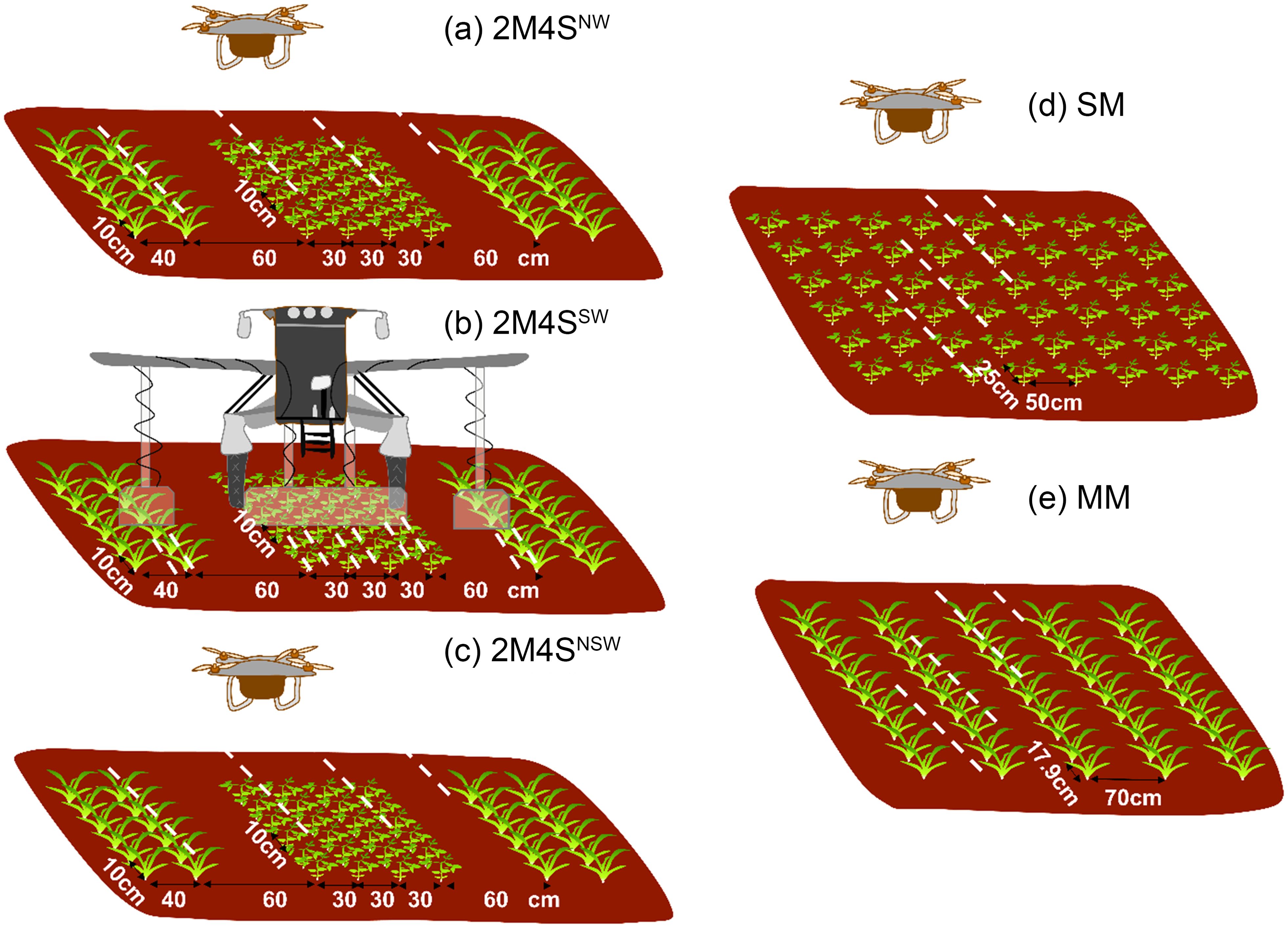
Figure 1. Representation of weed control and cultivation models in 2 experimental years. In maize soybean strip intercropping (with 2 rows of maize and 4 rows of soybean, 2M4S), three weed methods, (a) NW (no weed, spray with water by drones), (b) SW (Segregated weeding, based on a specialized dual-sys- tem isolated sprayer with separate herbicides for maize and soybean belt), and (c) NSW (Non-segregat- ed weeding, based on soybean and imidazolinone herbicide-tolerant maize that can share herbicides without isolated spraying by drones) were used for the experiment. Set soybean monoculture (SM, d) and maize monoculture (MM, e) to spray herbicide by drones with same herbicide of (c).
Each treatment plot measured 60 × 25 meters, with a planting density of 80,040 plants ha-¹ for maize and 160,080 plants ha-¹ for soybean in both monoculture systems (MM and SM) and the intercropping system (2M4S). The detailed layout of the experimental field is illustrated in Figure 1. All agronomic practices, including sowing, harvesting, and irrigation, were performed manually. Maize and soybean were planted on June 17th, 2021, and June 21st, 2022, and harvested on October 18th, 2021, and October 22nd, 2022. Fertilization was conducted using a synchronous sowing and fertilizing integrated machine. For maize, a slow/controlled-release compound fertilizer (N:P:K= 28:6:10) was applied at a rate of 750 kg ha-1. For soybean, a balanced/controlled-release compound fertilizer (N:P:K= 14:14:14) was applied at a rate of 150 kg ha-1.
2.3 Sampling and measurements
2.3.1 plant traits and total dry matter
Plant height, stem diameter, and leaf area were measured for nine maize and soybean plants at 45, 75, and 105 days after sowing (DAS). Leaf area was calculated by multiplying the maximum leaf width by the length and then applying a crop coefficient factor (0.72 for maize and 0.78 for soybean). After measurements, the shoots of both maize and soybean were separated into different tissues (leaves, stems, grains, and other parts). All plant samples were oven-dried initially at 105°C for 30 minutes, followed by drying at 80°C until a constant weight was achieved. These samples were then analyzed for total dry matter (TDM) accumulation and partitioning.
2.3.2 leaf area index and relative leaf area of weeds
The LAI was computed using Equation 1 (Raza et al., 2021):
The relative leaf area of weeds (Lw) is defined by Equation 2 as the ratio between the leaf area index (LAI) of the weed and the total LAI of the crop plus weeds (Kropff and Spitters, 1991):
where LAIw and LAIc are the leaf area index of the weed and crop, respectively. Here, LAIc is the sum of the leaf area index of maize and soybean. Lw can vary from 0 (absence of weeds) to 1 (leaf cover of the weed alone).
2.3.3 Land equivalent ratio
LER was calculated using Equation 3 (Mead and Willey, 1980).
where pLERm and pLERs are the partial land equivalent ratio of maize and soybean, respectively, Yim and Yis are the yields of maize and soybean in intercropping, and Ymm and Ysm are the yields of maize and soybean under the monoculture system, respectively.
2.3.4 Investigation of weed control efficacy
Four sampling points (each measuring 1 m × 1 m) were randomly selected within each plot. The number of weeds and their fresh weight were assessed 21 days after spraying. Weed control efficacy, based on both the number of weed plants and fresh weight, was calculated using the following Equations 4, 5.
where P is the weed control efficacy (%), NNW is the number of weed plants in the untreated area, NT is the number of weed plants in the area with weeding, W is fresh weight-based weed control (%), MNW is the fresh weight of weeds in the area without weeding (g), and MT is the fresh weight of weeds in the area with weeding (g).
2.4 Economic analysis
The economic analysis was conducted to evaluate both net income and costs associated with weed control, aiming to compare the effectiveness of different weed management methods. Costs were primarily based on expenses for land rental, seeds, fertilizers, pesticides, sowing, irrigation, harvesting, pesticide application, threshing, and drying for both maize and soybean, using local prices. The total production value was calculated from the harvested grain yield of maize and soybean, adjusted according to the prevailing market prices for each year. Net income was determined by subtracting the total costs from the total output. The cost of weed control was influenced by the total sprayed area, weed control efficacy, and herbicide dosage.
2.5 Statistical analysis
Data were analyzed using one-way analysis of variance (ANOVA) in IBM SPSS Statistics v22.0. Prior to analysis, the data were checked for normality and homogeneity. Treatment means were compared using Fisher’s Protected Least Significant Difference (LSD) test at a 0.05 probability level. The treatment means and standard errors presented in tables and figures were calculated based on at least three replicates per treatment.
3 Results
3.1 Plant traits and TDM accumulation
The weed control systems induced significant variations in plant traits and TDM, with these effects becoming increasingly pronounced by 105 days after sowing (DAS). The highest values for stem diameter, leaf area, and TDM were consistently observed in monoculture maize (MM) and soybean (SM), followed by the non-segregated weeding (NSW) system in the intercropped setup (2M4SNSW). Compared to the segregated weeding (SW) system (2M4SSW) and the no-weeding (NW) control (2M4SNW), the NSW system (2M4SNSW) significantly improved plant traits and TDM accumulation in both maize and soybean (Figures 2, 3). Averaged over two years, maize and soybean under the NSW system exhibited 12% and 13% higher leaf area, 4% and 17% greater stem diameter, and accumulated 10% and 17% more TDM, respectively, compared to those under the SW system.
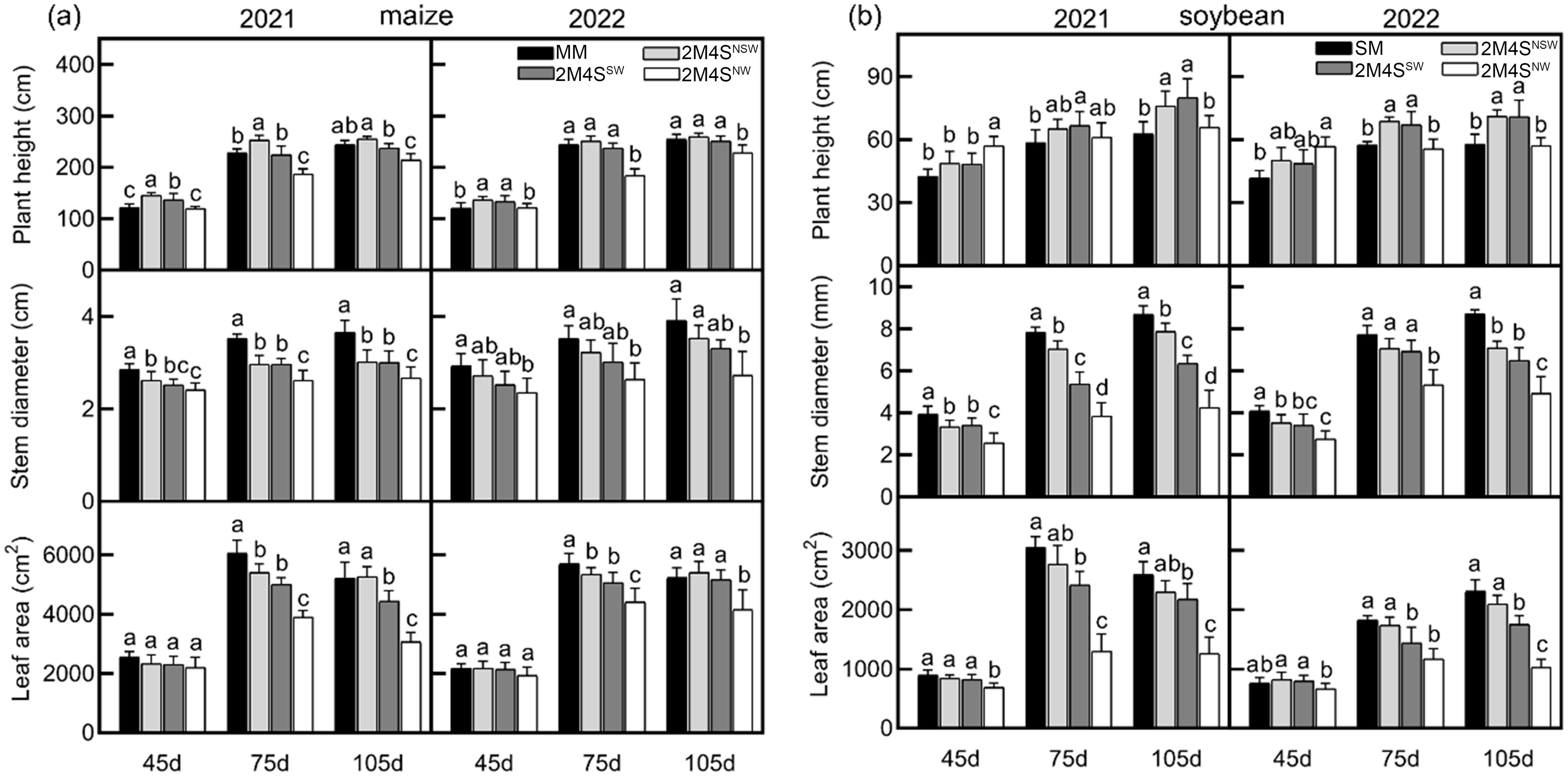
Figure 2. Plant height, stem diameter, and leaf area of maize (a) and soybean (b) at 45, 75, and 105 days in 2021 and 2022. The different lowercase letters represent significant differences at the 0.05 level for different treatments at the same measurement time.
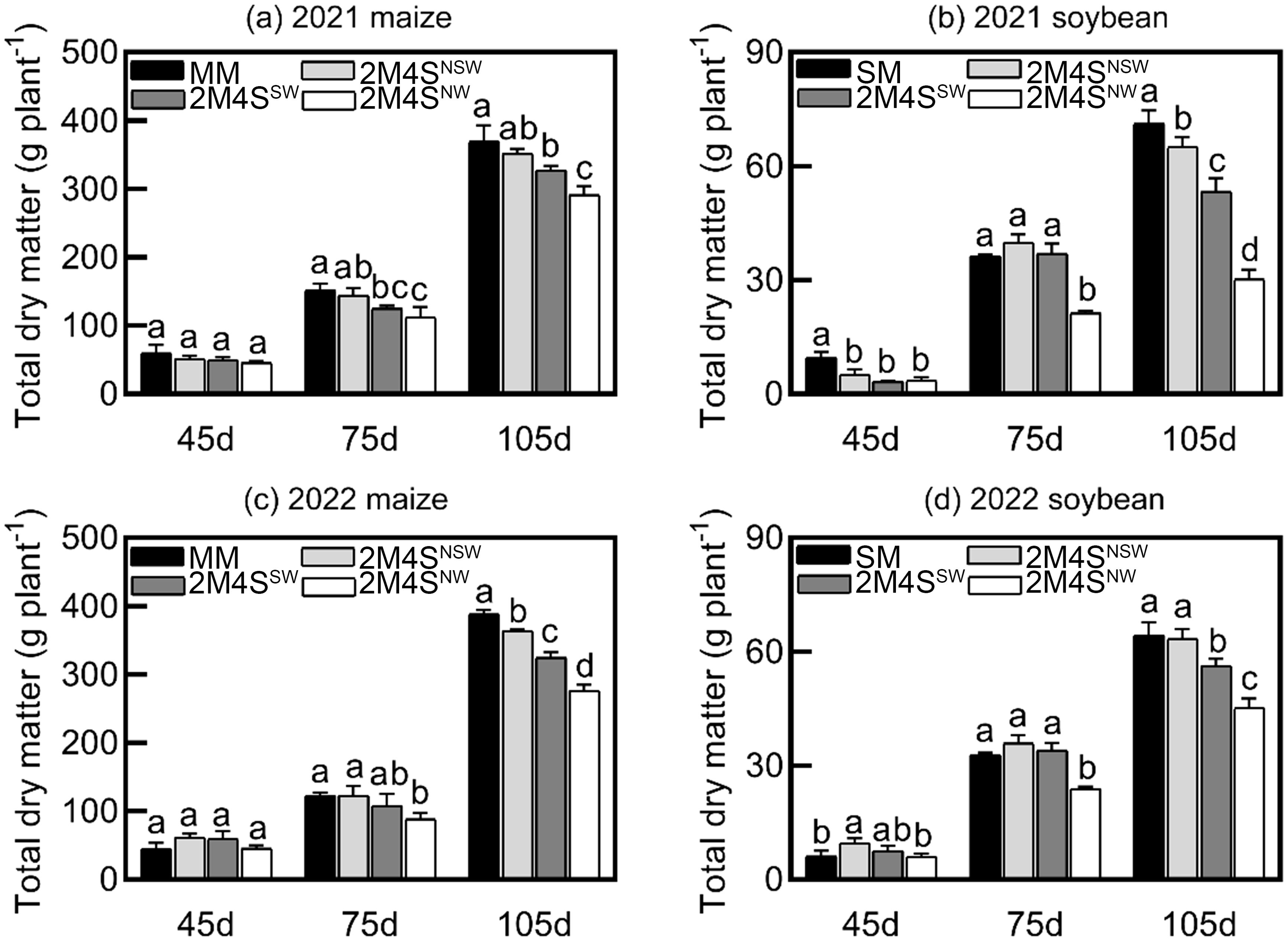
Figure 3. Total dry matter of maize at 45, 75, and 105 days in 2021 (a) and 2022 (c), total dry matter of soybean at 45, 75, and 105 days in 2021 (b) and 2022 (d). Different lowercase letters indicate significant differences at 0.05 level for different treatments at the same measurement time.
3.2 Leaf area index and relative leaf area of weeds
At 45 days after sowing (DAS), no significant differences were observed in the leaf area index (LAI) of maize and soybean across all treatments. Generally, the highest LAI was consistently observed in monoculture maize (MM) and soybean (SM) in both years (Figures 4a–d). However, in the intercropping systems (2M4SNSW, 2M4SSW, 2M4SNW), significant differences in LAI began to emerge at 75 DAS and became more pronounced by 105 DAS, particularly between the non-segregated weeding (NSW) and no-weeding (NW) treatments. Both maize and soybean exhibited significantly higher LAI in the 2M4SNSW system, followed by 2M4SSW and 2M4SNW. On average, the LAI of maize in the 2M4SNSW system was 10% and 52% higher than in the 2M4SSW and 2M4SNW systems, respectively (Figures 4a-d). Similarly, the LAI of soybean was 33% and 176% higher than in the 2M4SSW and 2M4SNW systems, respectively (Figures 4a-d). Consistently, the relative leaf area of weeds (Lw) was significantly lower in the 2M4SNSW system compared to the 2M4SSW and 2M4SNW systems (Figures 4e, f). No significant differences in Lw were observed between the NSW, SM, and MM treatments, indicating that the NSW weed control was comparable to that in the monoculture systems of maize and soybean.
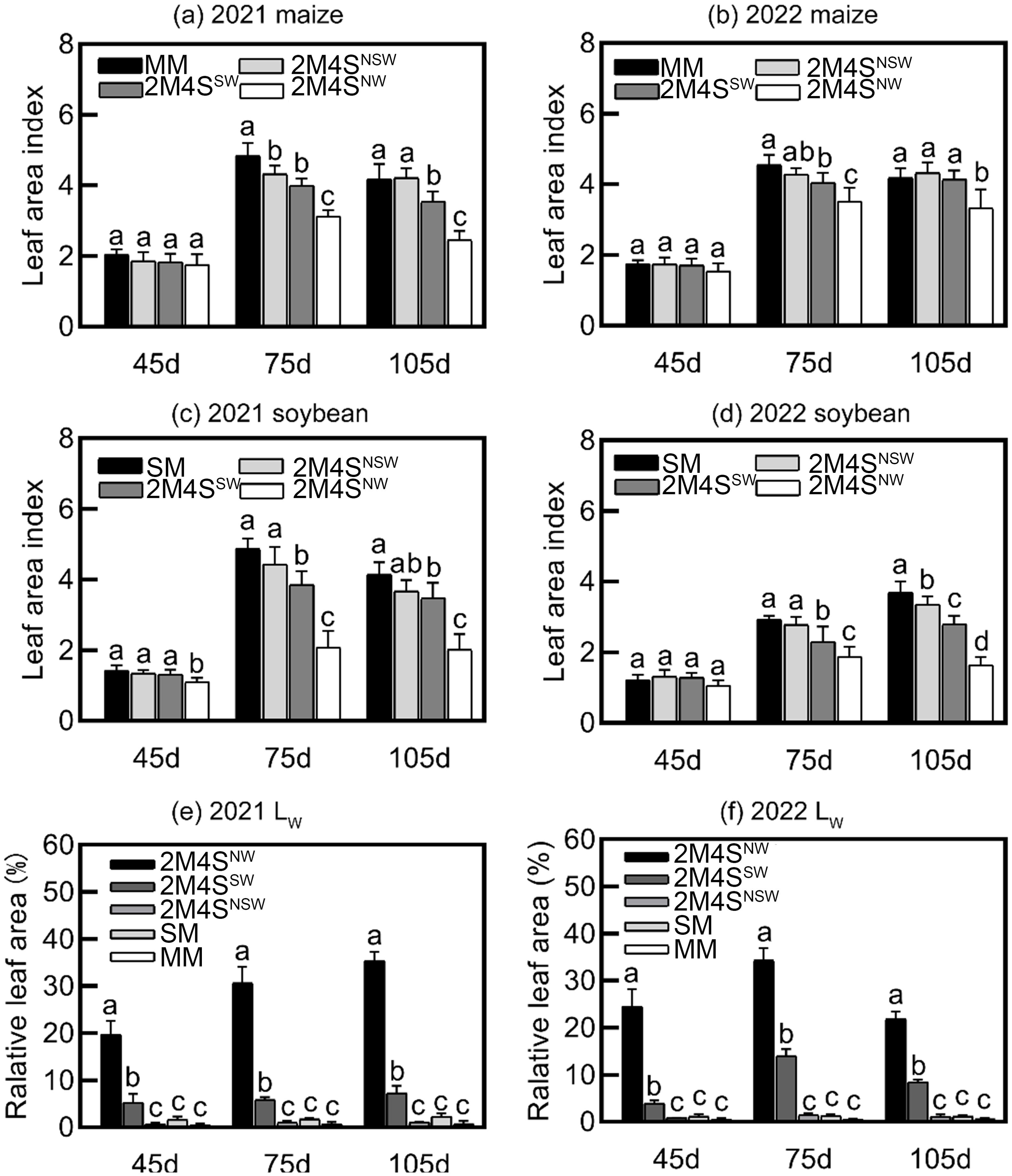
Figure 4. Leaf area index of maize at 45, 75, and 105 days in 2021 (a) and 2022 (b), leaf area index of soybean at 45, 75, and 105 days in 2021 (c) and 2022 (d), and relative leaf area of weeds at 45, 75, and 105 days in 2021 (e) and 2022 (f). Different lowercase letters indicate significant differences at 0.05 level for different treatments at the same measurement time.
3.3 Weed control efficiency
The NSW weed control method significantly suppressed weed incidence in both intercropping (2M4SNSW) and monocropping systems (SM and MM) over the two-year study period (Figure 5). Weed counts revealed the presence of three primary weed species: Gramineae (e.g., Digitaria sanguinalis L. and Eleusine indica L.), broadleaf weeds (e.g., Portulaca oleracea L. and Chenopodium album L.), and Cyperaceae (e.g., Cyperus rotundus L.). Further analysis showed that Gramineae were the most dominant, comprising 75% of the total weeds in 2021 and 53% in 2022 (Figures 5a, b, Table 2). Additionally, the proportion of Cyperaceae weeds increased from 5% in 2021 to 34% in 2022 (Figures 5a, b). The results related to the fresh weight of different weed species were consistent with these findings (Figures 5c, d, Table 3). In the intercropping system, the number of weed plants and the fresh weight of total weeds, Gramineae, broadleaf, and Cyperaceae species significantly decreased (p-value < 0.05) in the 2M4SNSW treatment compared to 2M4SSW and 2M4SNW. Over both years, the weed plant control efficacy in 2M4SNSW was 95% for total weeds, 95% for Gramineae, 96% for broadleaf weeds, and 95% for Cyperaceae—showing improvements of 20%, 16%, 33%, and 28%, respectively, compared to 2M4SSW (Table 2). Similarly, the fresh weight control efficacy in 2M4SNSW was 96% for total weeds, 96% for Gramineae, 96% for broadleaf weeds, and 95% for Cyperaceae—exceeding the efficacy in 2M4SSW by 15%, 12%, 29%, and 21%, respectively (Table 3). No significant differences (p-value > 0.05) were observed in the number of weed plants, fresh weight, or control efficacy between 2M4SNSW, SM, and MM (Figures 5a-d, Tables 2, 3).
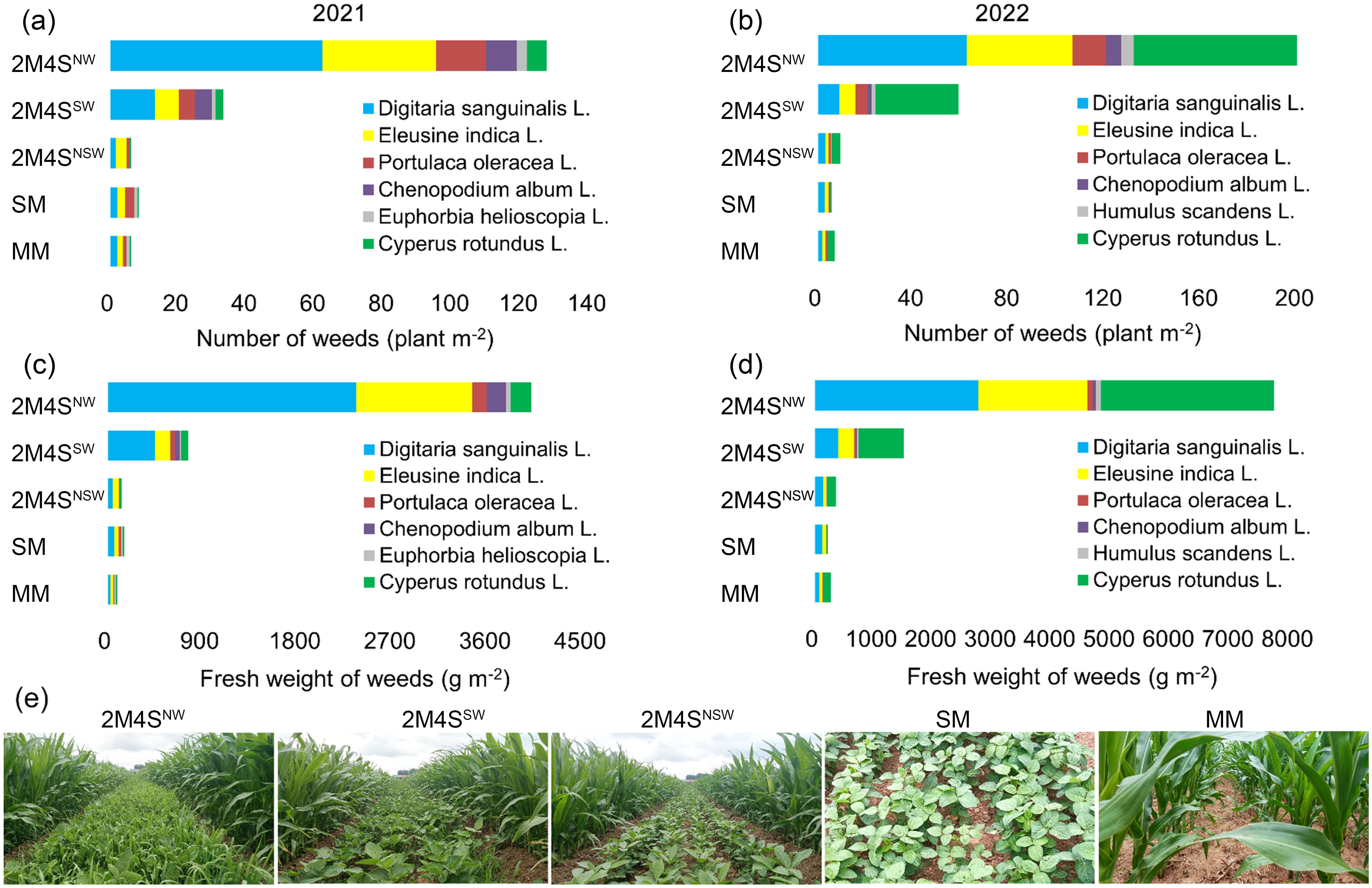
Figure 5. Number of weeds in 2021 (a) and 2022 (b), fresh weight of weeds in 2021 (c) and 2022 (d), and weeds incidence under different weeds control (e).
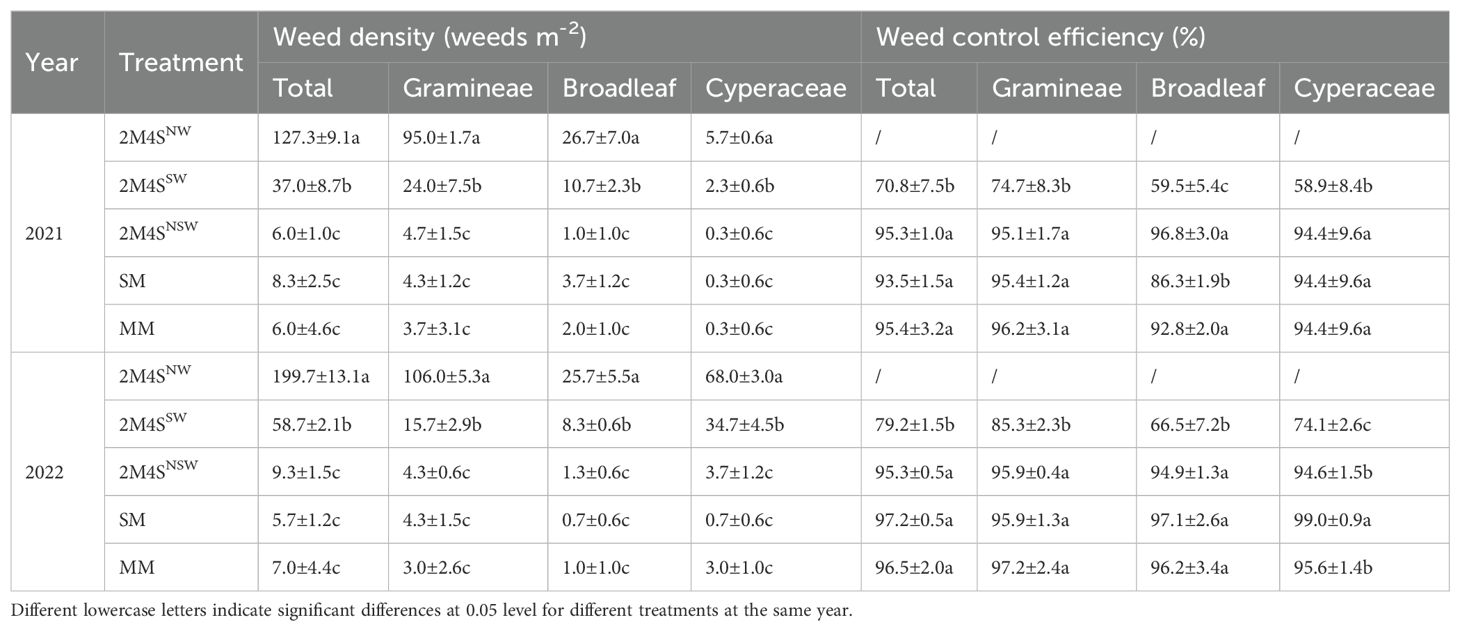
Table 2. Weed density and control efficiency in 2021 and 2022 under 2M4SNW, 2M4SSW, 2M4SNSW, SM, and MM.
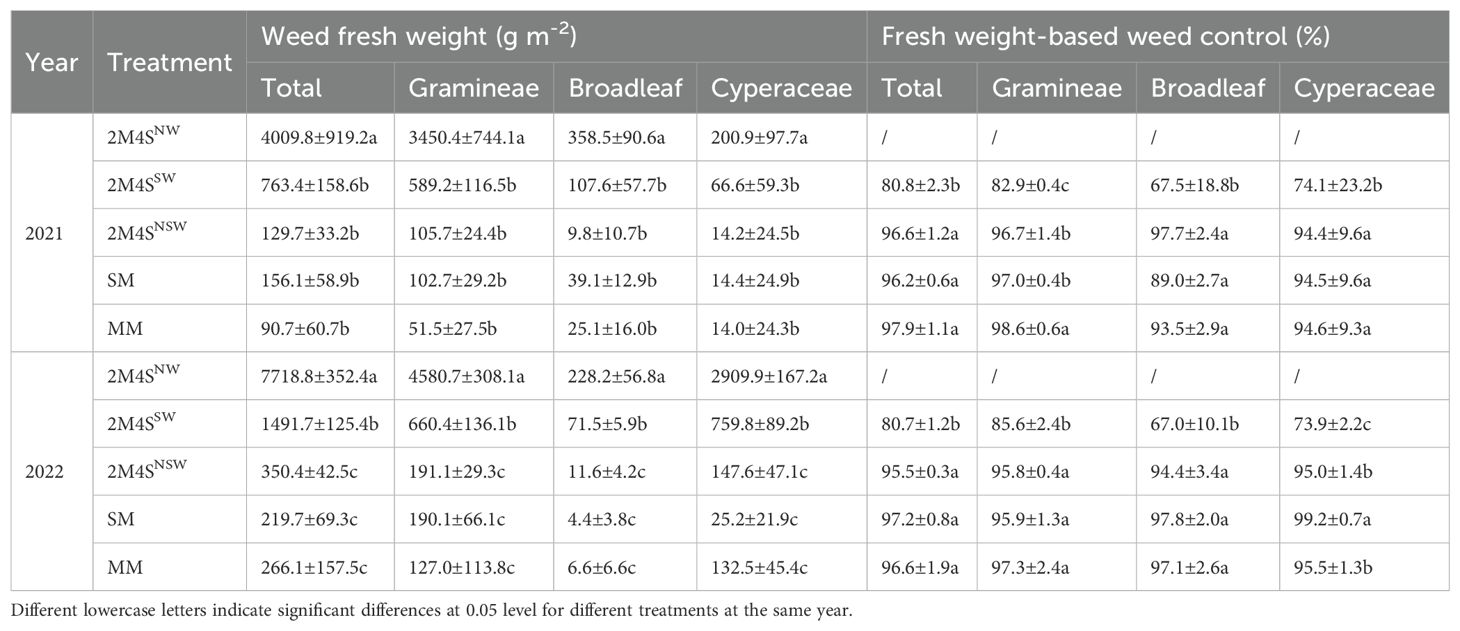
Table 3. Weed fresh weight and fresh weight-based weed control in 2021 and 2022 under 2M4SNW, 2M4SSW, 2M4SNSW, SM, and MM.
3.4 Grain yields
The two-year results showed that the highest yields for maize and soybean were consistently obtained in monoculture, except for the maize yield in 2M4SNSW in 2021, which was not significantly different (p-value > 0.05). However, within the intercropping systems, the NSW weed control method significantly increased the grain yield of both maize and soybean compared to SW and NW treatments. Averaged over the two years, maize yield in 2M4SNSW was 3% and 15% higher, and soybean yield was 99% and 186% higher, than in 2M4SSW and 2M4SNW, respectively. Notably, the highest maize and soybean yields in 2M4SNSW were recorded at 9483.1 kg ha-¹ and 2502.0 kg ha-¹, which represent 99% and 79% of the yields achieved in monoculture maize and soybean, respectively. Furthermore, except for the 2M4SNW treatment, the total grain yield in 2M4SNSW and 2M4SSW was 25% and 8% higher than in MM, indicating that effective weed management can enhance the productivity of maize-soybean intercropping systems.
3.5 Land equivalent ratio
The total land equivalent ratio (LER) values for the intercropping system ranged from 1.05 to 1.81 (total LER > 1), indicating that intercropping yielded better results than monoculture. Averaged over the two years, 2M4SNSW exhibited the highest total LER (1.78), followed by 2M4SSW (1.35) and 2M4SNW (1.14) (Table 4). The partial LER values for maize (pLERm) and soybean (pLERs) in the intercropping system ranged from 0.84 to 1.01 and 0.21 to 0.80, respectively, across both years (Table 4). Moreover, compared to 2M4SSW and 2M4SNW, the 2M4SNSW treatment recorded 3% and 101% higher pLERm, and 15% and 189% higher pLERs, respectively. The pLERm values for both 2M4SNSW and 2M4SSW were close to 1, indicating that with effective weed management, the yield of intercropped maize can approach that of monoculture maize (MM). The highest pLERs were consistently observed in the NSW treatment, with the average pLERs in 2M4SNSW being twice as high as in 2M4SSW.
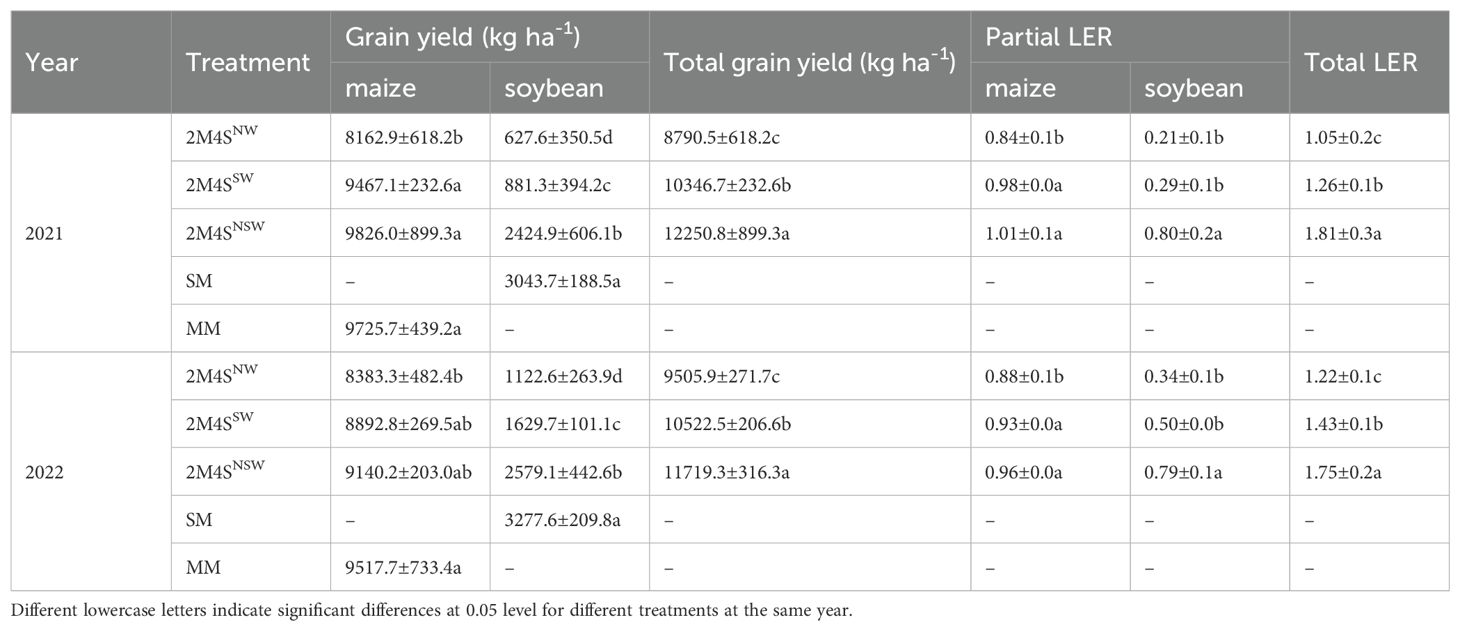
Table 4. Grain yield and land equivalent ratio (LER) of maize and soybean for different planting patterns in 2021 and 2022.
3.6 Economic analysis
The weed control method based on imidazolinone-tolerant maize directly impacted gross income, total expenditure, and net profit across different planting patterns (Table 5). In both years, gross income was higher for all intercropping weed control methods compared to monocropping, except for 2M4SNW in 2021, with the highest gross income observed in 2M4SNSW. Total expenditures were higher for intercropping than for monoculture, with the highest expenditures occurring in 2M4SSW. The difference in total expenditures between 2M4SSW and 2M4SNSW was primarily attributed to herbicide and weeding machinery costs. On average, 2M4SNSW resulted in savings of more than 37.05 USD ha-¹ compared to 2M4SSW. The highest net income was recorded in 2M4SNSW (3526.72 USD ha-¹ in 2021, 3301.52 USD ha-¹ in 2022), while the lowest net income was observed in SM (700.65 USD ha-¹ in 2021, 887.16 USD ha-¹ in 2022) (Table 5). Across both years, compared to SM and MM, the net income increased by an average of 338% and 102% for 2M4SNSW, and by 174% and 29% for 2M4SSW, respectively.
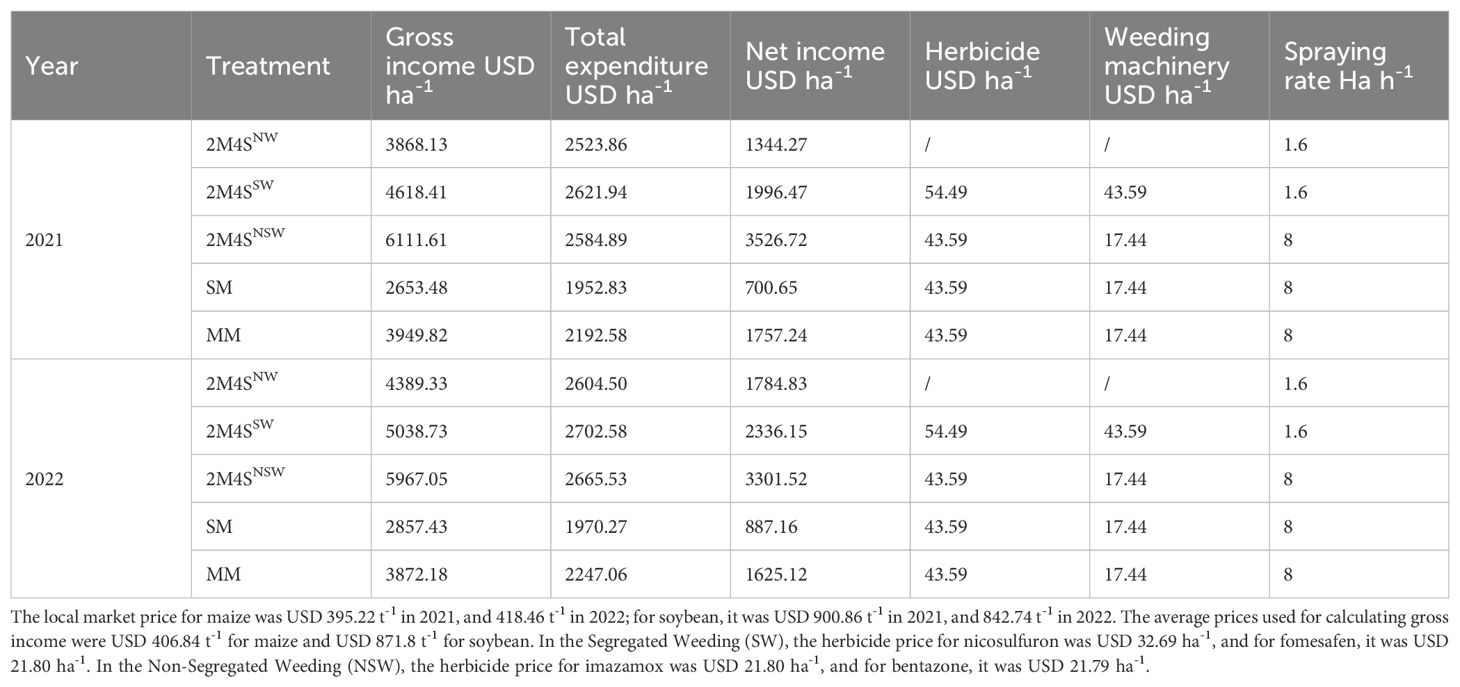
Table 5. Economic analysis for the effects of different weed control for different planting patterns in 2021 and 2022.
4 Discussion
Cereal-legume intercropping systems, such as maize-soybean strip intercropping, have been introduced to address food security concerns for the growing global population by increasing resource utilization efficiency while reducing inputs (Du et al., 2018). The maize-soybean strip intercropping system, with a land equivalent ratio (LER) greater than 1, demonstrates that vegetative diversity within the field creates an ecological niche that captures resources more effectively, resulting in greater biomass production compared to monocropping (Xu et al., 2020). However, the weeds that survive within this intercropping system compete aggressively with maize and soybean for essential resources, thereby limiting the economic output of the system. Therefore, selecting appropriate herbicides is crucial for effective weed management in modern agriculture (Swanton et al., 2008). The use of effective herbicides is particularly important in intercropping systems, where weed control can be more challenging (Strehlow et al., 2020).
Despite the benefits, the species diversity in maize-soybean strip intercropping and the absence of a common post-emergence herbicide complicate and increase the cost of weed management in a single operation. Farmers have traditionally relied on machine-mounted dual-spraying systems with separators (SW), which are difficult to manage due to the need for careful handling to avoid herbicide mixing, resulting in higher costs and lower efficiency. In response to these challenges, this study presents an inexpensive and effective weed control method based on herbicide-tolerant crops to enhance the yield and land-use efficiency of the maize-soybean strip intercropping system. Our findings demonstrate that the use of imidazolinone-tolerant maize in this intercropping system not only provides effective weed management but also significantly improves yields compared to monoculture systems and the traditional SW method.
Previous studies have shown that weed control systems employing imidazolinone-tolerant cereals and imidazolinone herbicides are effective in managing weeds that are difficult to control with other herbicides, such as red rice in rice (Oryza sativa L.) and goat grass in wheat (Triticum aestivum L.) (Tan et al., 2005). Imidazolinone herbicides target the enzyme acetohydroxyacid synthase (AHAS) or acetolactate synthase, inhibiting the biosynthesis of branched-chain amino acids in plants (Folberth et al., 2020). These herbicides are particularly effective against a broad spectrum of grass, broadleaf, and sedge weeds, including those closely resembling the crop itself (Tan et al., 2005). Importantly, imidazolinone herbicides can be applied to soybean without targeted resistance, as they are rapidly metabolized, preventing toxicity in the soybean plants (Tecle et al., 1993). In our study, we applied imidazolinone as a common herbicide by introducing imidazolinone-tolerant maize into the maize-soybean intercropping system. The maize used in our study is capable of tolerating more than four times the registered dose of imidazolinone. In addition, bentazone, a selective post-emergence (POST) herbicide, has been successfully used in maize-soybean strip intercropping, primarily for controlling broadleaf and sedge weeds, though it is less effective against grasses (Dai et al., 2017; Ali et al., 2020). Therefore, the combination of imidazolinone (imazamox) and bentazone (NSW) in our study expanded the weed control spectrum, enhanced weed control efficacy, and reduced crop-weed competition.
In this study, the combination of imazamox and bentazone (NSW) was used for the first time in the maize-soybean strip intercropping system, and it demonstrated a broader herbicidal spectrum and higher weed control efficacy compared to the existing nicosulfuron + fomesafen (SW) system (Tables 2, 3, Figure 5), particularly in controlling Cyperaceae weeds. For instance, the weed control efficacy and fresh weight control efficacy of 2M4SNSW for Cyperaceae were over 95%, significantly higher than the 60-70% efficacy observed with 2M4SSW (Figures 5a-d). Furthermore, our two-year data on LAI, TDM in maize and soybean, and the relative leaf area of weeds (Lw) indicated that 2M4SNSW effectively reduced competition between intercropped species and weeds compared to 2M4SSW. Thus, our findings confirm that the introduction of imidazolinone-tolerant maize combined with the NSW system can be adopted as a reliable, effective, and broad-spectrum POST weed control method for maize-soybean strip intercropping.
One of the main reasons farmers adopt the maize-soybean strip intercropping system is its ability to increase land productivity while reducing inputs, as evidenced by its higher land equivalent ratio (LER > 1) compared to sole cropping systems. Our results also demonstrated the yield and land-use advantages of maize-soybean intercropping over monoculture. Additionally, the convenient and effective weed control achieved through the NSW method significantly reduced weed-crop competition, leading to enhanced land efficiency and increased grain yield, particularly for soybean. We found that the 2M4SNSW method produced 102% higher total grain yield and 99% higher soybean yield compared to the 2M4SSW method, while the maize yield did not differ significantly between the two weed control systems. The highest total LER values of 1.81 in 2021 and 1.75 in 2022 further confirm that using imidazolinone-tolerant maize for weed management can substantially improve land use efficiency in maize-soybean intercropping without compromising maize yield.
Previous studies have shown that weeds in soybean-based intercropping systems primarily originate from soybean rows and can severely reduce soybean yield (Cheriere et al., 2020). In contrast, the competitive advantage of maize, supported by narrow row spacing and high planting density, significantly suppresses weed biomass (Begna et al., 2001; Marín and Weiner, 2014; Teasdale, 1995). Our results are consistent with these findings, as the average pLERs of 2M4SNSW was twice as high as that of 2M4SSW, while there was no significant difference (p-value > 0.05) in pLERm between 2M4SNSW and 2M4SSW. These findings indicate that soybean yield in intercropping strongly depends on the effectiveness of weed control. The higher LER observed in 2M4SNSW is primarily driven by the increased soybean yield, which corresponds to the reduced weed pressure on soybean achieved through the NSW method.
The utilization of herbicide-tolerant maize in maize-soybean intercropping can significantly improve weed control efficacy while reducing associated costs. For example, in the imidazolinone-tolerant maize-soybean intercropping system, imidazolinone herbicides can be applied using drones, unlike the SW method, which requires a hooded sprayer to separately apply post-emergence (POST) herbicides. The SW method has three major drawbacks compared to NSW: a narrower weed control spectrum, increased herbicide usage, and higher mechanical costs, along with the risk of herbicide-induced crop damage. In contrast, the NSW method is five times faster (8 ha h-¹) than SW (1.6 ha h-¹), offering potential savings in both time and money. Our economic comparison of the two weed control systems confirmed this, showing that the 2M4SNSW system saved 37.05 USD ha-¹ in herbicide and weeding machinery costs compared to 2M4SSW. Additionally, the net income of the 2M4SNSW system was estimated at 3414.12 USD ha-¹ over two years, representing an impressive 57.6% and 101.2% increase compared to 2M4SSW and MM, respectively (Table 5). These results are consistent with previous studies, which have shown that herbicide-tolerant crops can reduce weed control costs, improve yields, and increase overall benefits (Brookes and Barfoot, 2020; Green, 2012). Our findings, along with the successful use of herbicide-tolerant crops in other systems for weed control and yield optimization (Bonny, 2016; Gianessi, 2008; Liu et al., 2020; Watkinson et al., 2000), suggest that the development of herbicide-tolerant crops is a critical trend for the future of weed management in intercropping systems.
Current weed control practices in maize-soybean intercropping primarily rely on pre-emergence herbicides (Prasad and Rafey, 1995; Singh et al., 2005; Gupta and Singh, 2017; Bibi et al., 2019; Singh and Longkumer, 2021; Geng et al., 2023), including acetochlor, metolachlor, S-metolachlor, pendimethalin, flumetsulam, thifensulfuron-methyl, and metribuzin (Gupta and Singh, 2017). However, these soil-applied herbicides face two critical limitations: (1) Narrow application window: Treatments must be strictly timed between sowing and crop emergence (0–48 h), and the soil needs to be at least 50% water, leaving minimal flexibility; (2) Inability to suppress late-emerging weeds: Persistent gaps in weed management occur due to uncontrolled weed growth during later crop stages. Furthermore, post-emergence herbicide options are severely limited in this system. While bentazon, a broadleaf-specific herbicide, is approved for both crops (Dykun et al., 2020; Saad et al., 2004), no graminicide are registered for simultaneous use in maize and soybean. This regulatory gap highlights the urgent need to develop graminicide-tolerant maize or soybean varieties.
There are few reports on simultaneous weed control of herbicide-resistant crops in intercropping, which is related to farming systems in different countries. For example, herbicide-resistant crop of herbicide rotations are more commonly reported in American and European countries (Lamichhane et al., 2017; Marochi et al., 2018), but intercropping with same-season normal crops in Asia (Singh et al., 2005; Singh and Longkumer, 2021; Geng et al., 2023). A German study documented maize and soybean intercropping for weed control, where staggered sowing of maize and soybean enabled sequential pre- and post-emergence mechanical weeding combined with herbicide applications (Andert, 2021). However, in Asia (particularly China), synchronous sowing of maize and soybean makes separate weed management for the two crops highly inconvenient. Although the imidazolinone-resistant (graminicide-tolerant) maize soybean intercropping system described in this study reduces costs and improves operational convenience, it remains imperfect.
It has been reported that the persistence of imidazolinone herbicides in the soil can potentially harm subsequent crops (Gehrke et al., 2021). However, certain soil conditions—such as higher pH, lower clay content, moderate organic matter, higher soil moisture, and elevated temperatures—can promote the dissipation of these herbicides (Gehrke et al., 2021). To mitigate the residual effects on the following season’s crops, it is recommended to use appropriate herbicide concentrations at the correct timing, combined with other broadleaf herbicides like bentazone and fluthiacet-methyl. Furthermore, the development of herbicide-tolerant crops, such as maize tolerant to Acetyl CoA carboxylase (ACCase, EC: 6.4.1.2) inhibitors, soybean tolerant to 4-Hydroxyphenylpyruvate dioxygenase (HPPD, EC:1.13.11.27) inhibitors, or maize and soybean tolerant to non-selective herbicides (e.g., glyphosate and ammonium-glyphosate), could provide new solutions for maize-soybean strip intercropping weed control. These herbicides typically have shorter residual periods and pose less risk to successive crops. Adopting a rotation of these crops and corresponding herbicides could serve as a sustainable practice to address weed management challenges in maize-soybean strip intercropping. Overall, our results suggest that weed control based on herbicide-tolerant maize enhances integrated weed management and is more profitable, yielding higher net income with fewer inputs in the maize-soybean intercropping system. This strategy offers a convenient, economical, and efficient approach to weed control in intercropping and mixed cropping systems.
5 Conclusion
Imidazolinone herbicides can be safely and effectively applied for weed control in an imidazolinone-tolerant maize-soybean intercropping system, eliminating the need for multiple herbicides and complex spraying equipment like hooded sprayers. The superior weed control efficacy and the ability to mimic monoculture traits for herbicide application suggest that the herbicide-tolerant approach used in our study could greatly simplify weed management in strip intercropping systems. With this approach, growers can uniformly apply a single herbicide to both maize and soybean in a maize-soybean strip intercropping system using any convenient method—whether hand-held sprayers, self-propelled sprayers, or drones—depending on the size of the farmland and available resources. Our results demonstrated that the imidazolinone-tolerant NSW method effectively suppressed weed pressure in soybean rows, leading to improved grain yields (98.6% of MM yields and 79.2% of SM yields in the 2M4S system) and net profits exceeding 3000 USD ha-¹, which were significantly higher than the profits from individual MM and SM systems. This indicates that effective weed management in maize-soybean strip intercropping can offer substantial returns to farmers, contributing to meeting the food needs of a growing population through sustainable crop production, particularly in resource-limited regions such as China. However, further research is needed to evaluate the suitability of various weed species and control methods across different ecological zones, as well as to assess the impact of herbicides on the growth of subsequent crops.
Data availability statement
The original contributions presented in the study are included in the article/Supplementary Material. Further inquiries can be directed to the corresponding author.
Author contributions
YZ: Data curation, Formal analysis, Investigation, Methodology, Visualization, Writing – original draft, Writing – review & editing. AM: Data curation, Validation, Writing – original draft, Writing – review & editing. MA: Formal analysis, Methodology, Software, Writing – review & editing. WY: Conceptualization, Project administration, Validation, Writing – review & editing. JY: Data curation, Formal analysis, Software, Writing – review & editing. XD: Conceptualization, Funding acquisition, Project administration, Resources, Supervision, Validation, Writing – original draft, Writing – review & editing. LF: Conceptualization, Data curation, Formal analysis, Funding acquisition, Investigation, Methodology, Project administration, Resources, Software, Supervision, Validation, Visualization, Writing – original draft, Writing – review & editing.
Funding
The author(s) declare that financial support was received for the research and/or publication of this article. This work was supported by The National Key Research and Development Program of China (No. 2022YFD2300901), Major Science and Technology Projects in Biological Breeding (No. 2022ZD04005), and Shandong Provincial Natural Science Foundation (ZR2023QC063 and SYS202206).
Conflict of interest
The authors declare that the research was conducted in the absence of any commercial or financial relationships that could be construed as a potential conflict of interest.
Publisher’s note
All claims expressed in this article are solely those of the authors and do not necessarily represent those of their affiliated organizations, or those of the publisher, the editors and the reviewers. Any product that may be evaluated in this article, or claim that may be made by its manufacturer, is not guaranteed or endorsed by the publisher.
Supplementary material
The Supplementary Material for this article can be found online at: https://www.frontiersin.org/articles/10.3389/fagro.2025.1498417/full#supplementary-material
References
Ali L., Jo H., Song J. T., and Lee J. D. (2020). The prospect of bentazone-tolerant soybean for conventional cultivation. Agronomy 10, 1650. doi: 10.3390/agronomy10111650
Anderson P. C. and Hibberd K. A. (1988). Herbicide resistance in plants U.S. Patent. 4,761,373 Washington, DC: Patent and Trademark Office.
Andert S. (2021). The Method and Timing of Weed Control Affect the Productivity of Intercropped Maize (Zea mays L.) and Bean (Phaseolus vulgaris L.). Agriculture 11, 380. doi: 10.3390/agriculture11050380
Ban Z., Niu C., Li L., Gao Y., Liu L., Lu J., et al. (2024). Exogenous brassinolides and calcium chloride synergically maintain quality attributes of jujube fruit (Ziziphus jujuba Mill.). Postharvest Biol. Technol. 216, 113039. doi: 10.1016/j.postharvbio.2024.113039
Begna S., Hamilton R., Dwyer L., Stewart D., Cloutier D., Assemat L., et al. (2001). Morphology and yield response to weed pressure by maize hybrids differing in canopy architecture. Eur. J. Agron. 14, 293–302. doi: 10.1016/S1161-0301(01)00092-2
Bibi S., Khan I. A., Hussain Z., Zaheer S., and Shah S. M. A. (2019). Effect of herbicides and intercropping on weeds and yields of maize and the associated intercrops. Pak. J. Bot. 51, 1113–1120. doi: 10.30848/PJB2019-3(45
Bonny S. (2016). Genetically modified herbicide-tolerant crops, weeds, and herbicides: overview and impact. Environ. Manage. 57, 31–48. doi: 10.1007/s00267-015-0589-7
Brookes G. and Barfoot P. (2020). GM crop technology use 1996-2018: farm income and production impacts. GM Crops Food 11, 242–261. doi: 10.1080/21645698.2020.1779574
Chai Q., Nemecek T., Liang C., Zhao C., Yu A., Coulter J. A., et al. (2021). Integrated farming with intercroping increases food production while reducing environmental footprint. Proc. Natl. Acad. Sci. 118, e2106382118. doi: 10.1073/pnas.2106382118
Cheriere T., Lorin M., and Corre-Hellou G. (2020). Species choice and spatial arrangement in soybean-based intercropping: Levers that drive yield and weed control. Field Crops Res. 256, 107923. doi: 10.1016/j.fcr.2020.107923
Dai W., Yang J., Wang X., Yong T., Wang Q., Zhou X., et al. (2017). The influence of different herbicides on intercropping soybean and maize. Soybean Sci. (in Chinese) 36, 287–294. doi: 10.11861/j.issn.1000-9841.2017.02.0287
Du J., Han T., Gai J., Yong T., Sun X., Wang X., et al. (2018). Maize-soybean strip intercropping: Achieved a balance between high productivity and sustainability. J. Integr. Agr. 17, 747–754. doi: 10.1016/S2095-3119(17)61789-1
Dykun A., Zherebko V., and Dykun M. (2020). The effectiveness of herbicides in soybean cultivation. Žemės Ūkio Moksl. 27, 115–124. doi: 10.6001/zemesukiomokslai.v27i3.4341
Feng L., Raza M. A., Shi J., Ansar M., Titriku J. K., Meraj T. A., et al. (2020). Delayed maize leaf senescence increases the land equivalent ratio of maize soybean relay intercropping system. Eur. J. Agron. 118, 126092. doi: 10.1016/j.eja.2020.126092
Feng C., Sun Z., Zhang L., Feng L., Zheng J., Bai W., et al. (2021). Maize/peanut intercroping increases land productivity: A meta-analysis. Field Crops Res. 270, 108208. doi: 10.1016/j.fcr.2021.108208
Folberth C., Khabarov N., Balkovič J., Skalský R., Visconti P., Ciais P., et al. (2020). The global cropland-sparing potential of high-yield farming. Nat. Sustain. 3, 281–289. doi: 10.1038/s41893-020-0505-x
Gehrke V. R., Fipke M. V., Avila L. A., and Camargo E. R. (2021). Understanding the opportunities to mitigate carryover of imidazolinone herbicides in lowland rice. Agricultur 11, 299. doi: 10.3390/agriculture11040299
Geng Y. L., Wang H., Wang L. H., Liu M. X., Hao W. X., Liu X. M., et al. (2023). Effects of 10 pre-emergence herbicides applied in soybean-maize strip intercropping field. Acta Agrestia Sin. 31, 2890–2896. doi: 10.11733/j.issn.1007-0435.2023.09.035
Gianessi L. P. (2008). Economic impacts of glyphosate-resistant crops. Pest Manage. Sci. 64, 346–352. doi: 10.1002/ps.1490
Green J. M. (2012). The benefits of herbicide-resistant crops. Pest Manage. Sci. 68, 1323–1331. doi: 10.1002/ps.3374
Gupta D. D. and Singh B. P. (2017). Effect of weed management practices and levels of nitrogen on weed dynamics, yield and economics of maize-soybean inter cropping system. Ann. Plant Soil Res. 19, 159–167. Available at: https://gkvsociety.com/boxes.php?journal_id=18^^2017%20Volume%2019^^Number-2%20[JUNE]
Hoegh-Guldberg O., Jacob D., Taylor M., Guillén Bolaños T., Bindi M., Brown S., et al. (2019). The human imperative of stabilizing global climate change at 1.5 C. Science 365, eaaw6974. doi: 10.1126/science.aaw6974
Huang J., Ma H., Sedano F., Lewis P., Liang S., Wu Q., et al. (2019). Evaluation of regional estimates of winter wheat yield by assimilating three remotely sensed reflectance datasets into the coupled WOFOST–PROSAIL model. Eur. J. Agron. 102, 1–13. doi: 10.1016/j.eja.2018.10.008
Kropff M. and Spitters C. (1991). A simple model of crop loss by weed competition from early observations on relative leaf area of the weeds. Weed Res. 31, 97–105. doi: 10.1111/j.1365-3180.1991.tb01748.x
Lamichhane J. R., Devos Y., Beckie H. J., Owen M. D., Tillie P., Messéan A., et al. (2017). Integrated weed management systems with herbicide-tolerant crops in the European Union: lessons learnt from home and abroad. Crit. Rev. Biotechnol. 37, 459–475. doi: 10.1080/07388551.2016.1180588
Li C., Hoffland E., Kuyper T. W., Yu Y., Zhang C., Li H., et al. (2020). Syndromes of production in intercropping impact yield gains. Nat. Plants 6, 653–660. doi: 10.1038/s41477-020-0680-9
Li C., Stomph T.-J., Makowski D., Li H., Zhang C., Zhang F., et al. (2023). The productive performance of intercropping. Proc. Natl. Acad. Sci. 120, e2201886120. doi: 10.1073/pnas.2201886120
Liebman M. and Dyck E. (1993). Crop rotation and intercroping strategies for weed management. Ecol. Appl. 3, 92–122. doi: 10.2307/1941795
Liu C., Neve P., Glasgow L., Wuerffel R. J., Owen M. D., and Kaundun S. S. (2020). Modeling the sustainability and economics of stacked herbicide-tolerant traits and early weed management strategy for waterhemp (Amaranthus tuberculatus) control. Weed Sci. 68, 179–185. doi: 10.1017/wsc.2020.6
Liu X., Rahman T., Song C., Su B., Yang F., Yong T., et al. (2017). Changes in light environment, morphology, growth and yield of soybean in maize-soybean intercropping systems. Field Crops Res. 200, 38–46. doi: 10.1016/j.fcr.2016.10.003
Marín C. and Weiner J. (2014). Effects of density and sowing pattern on weed suppression and grain yield in three varieties of maize under high weed pressure. Weed Res. 54, 467–474. doi: 10.1111/wre.12101
Marochi A., Ferreira A., Takano H. K., Oliveira R. S., and Ovejero R. F. L. (2018). Managing glyphosate-resistant weeds with cover crop associated with herbicide rotation and mixture. Cienc. e Agrotecnologia. 42, 381–394. doi: 10.1590/1413-70542018424017918
Mead R. and Willey R. (1980). The concept of a ‘land equivalent ratio’and advantages in yields from intercropping. Exp. Agric. 16, 217–228. doi: 10.1017/S0014479700010978
Nelson G. C., Rosegrant M. W., Palazzo A., Gray I., Ingersoll C., Robertson R., et al. (2010). Food security, farming, and climate change to 2050: scenarios, results, policy options (Washington DC: Intl Food Policy Res Inst).
Prasad K. and Rafey A. (1995). Weed control in maize (Zea mays) intercropped with soybean (Glycine max). Indian J. weed Sci. 27, 167–169. Available at: https://indianjournals.com/ijor.aspx?target=ijor:ijws&volume=27&issue=3and4&article=014
Raza M. A., Din A. M. U., Yasin H. S., Gul H., Saeed A., Mehmood A., et al. (2025). Yield gains and resource use advantages driven by legume choice and row ratio in cotton/legume intercropping under arid-irrigated conditions. Field Crops Res. 324, 109789. doi: 10.1016/j.fcr.2025.109789
Raza M. A., Feng L. Y., van der Werf W., Iqbal N., Khan I., Khan A., et al. (2020). Optimum strip width increases dry matter, nutrient accumulation, and seed yield of intercrops under the relay intercropping system. Food Energy Secur. 9, e199. doi: 10.1002/fes3.199
Raza M. A., Gul H., Wang J., Yasin H. S., Qin R., Khalid M. H. B., et al. (2021). Land productivity and water use efficiency of maize-soybean strip intercropping systems in semi-arid areas: A case study in Punjab Province, Pakistan. J. Clean. Prod. 308, 127282. doi: 10.1016/j.jclepro.2021.127282
Saad E. I., Din S. A., Messiha N. K., and Metwally G. M. (2004). Response of maize and associated weeds to some post· emergence herbicides. J. Plant Prod. 29 (3), 1227–1237. doi: 10.21608/jpp.2004.238579
Shaner D. L., Bascomb N. F., and Smith W. (1996). “Imidazolinoneresistant crops: selection, characterization and management,” in Herbicide resistant crops. Ed. Duke S. O. (CRC Press, Boca Raton), 143–157.
Singh C. R. and Longkumer L. T. (2021). Effect of maize (Zea mays L.) and legume intercropping systems on weed dynamics. IJBSM. 12, 463–467. doi: 10.23910/1.2021.2427
Singh M., Singh P., and Nepalia V. (2005). Integrated weed management studies in maize based intercropping system. Indian J. weed Sci. 37, 205–208. Available at: https://www.indianjournals.com/ijor.aspx?target=ijor:ijws&volume=37&issue=3and4&article=012
Sterling T. M. and Balke N. E. (1989). Differential bentazon metabolism and retention of bentazon metabolites by plant cell cultures. Pest Biochem. Physiol. 34, 39–48. doi: 10.1016/0048-3575(89)90139-9
Strehlow B., De Mol F., and Gerowitt B. (2020). Herbicide intensity depends on cropping system and weed control target: Unraveling the effects in field experiments. Crop Protect. 129, 105011. doi: 10.1016/j.cropro.2019.105011
Swanton C. J., Mahoney K. J., Chandler K., and Gulden R. H. (2008). Integrated weed management: knowledge-based weed management systems. Weed Sci. 56, 168–172. doi: 10.1614/WS-07-126.1
Tan S., Evans R. R., Dahmer M. L., Singh B. K., and Shaner D. L. (2005). Imidazolinone-tolerant crops: history, current status and future. Pest Manage. Sci. 61, 246–257. doi: 10.1002/ps.993
Teasdale J. R. (1995). Influence of narrow row/high population maize (Zea mays) on weed control and light transmittance. Weed Technol. 9, 113–118. doi: 10.1017/S0890037X00023046
Tecle B., Dacunha A., and Shaner D. L. (1993). Differential routes of metabolism of imidazolinones: basis for soybean (Glycine max) selectivity. Pestic. Biochem. Physiol. 46, 120–130. doi: 10.1006/pest.1993.1043
Thornton P. K., Ericksen P. J., Herrero M., and Challinor A. J. (2014). Climate variability and vulnerability to climate change: a review. Global Change Biol. 20, 3313–3328. doi: 10.1111/gcb.12581
Tian X., Engel B. A., Qian H., Hua E., Sun S., and Wang Y. (2021). Will reaching the maximum achievable yield potential meet future global food demand? J. Clean. Prod. 294, 126285. doi: 10.1016/j.jclepro.2021.126285
United Nations (2022). World Population Prospects: The 2022 Revision (Department of Economic and Social Affairs). Available online at: https://population.un.org/dataportal/home (Accessed January 10, 2023).
Usui K. (2001). Metabolism and selectivity of rice herbicides in plants. Weed Biol. Manage. 1, 137–146. doi: 10.1046/j.1445-6664.2001.00029.x
Watkinson A. R., Freckleton R., Robinson R., and Sutherland W. J. (2000). Predictions of biodiversity response to genetically modified herbicide-tolerant crops. Science 289, 1554–1557. doi: 10.1126/science.289.5484.1554
Wang Y., Chai Q., Zhao C., Yin W., Hu F., Yu A., et al (2024). Above-and below-ground interactions and interspecific relationships in wheat/maize systems. Agronomy. 14 (8), 1683. doi: 10.3390/agronomy14081683
Wu K., Fullen M. A., An T., Fan Z., Zhou F., Xue G., et al. (2012). Above-and below-ground interspecific interaction in intercropped maize and potato: A field study using the ‘target’technique. Field Crops Res. 139, 63–70. doi: 10.1016/j.fcr.2012.10.002
Xu Z., Li C., Zhang C., Yu Y., van der Werf W., and Zhang F. (2020). Intercropping maize and soybean increases efficiency of land and fertilizer nitrogen use; A meta-analysis. Field Crops Res. 246, 107661. doi: 10.1016/j.fcr.2019.107661
Yang F., Huang S., Gao R., Liu W., Yong T., Wang X., et al. (2014). Growth of soybean seedlings in relay strip intercropping systems in relation to light quantity and red: far-red ratio. Field Crops Res. 155, 245–253. doi: 10.1016/j.fcr.2013.08.011
Yi J., Li H., Zhao Y., Zhang H., and Liu M. (2022). Assessing soil water balance to optimize irrigation schedules of flood-irrigated maize fields with different cultivation histories in the arid region. Agric. Water Manage. 265, 107543. doi: 10.1016/j.agwat.2022.107543
Zhang C., Ren Y., Yan M., Sang T., Li H., Chen Y., et al. (2022). Stable isotopes δ18O and δ2H reveal differential water uptake from intercropped maize and soybean soil profiles. Field Crops Res. 288, 108695. doi: 10.1016/j.fcr.2022.108695
Zhao J., Bedoussac L., Sun J., Chen W., Li W., Bao X., et al. (2023). Competition-recovery and overyielding of maize in intercropping depend on species temporal complementarity and nitrogen supply. Field Crops Res. 292, 108820. doi: 10.1016/j.fcr.2023.108820
Keywords: herbicide-tolerant maize, weeds, imidazolinone, soybean, intercropping
Citation: Zhao Y, Mohi Ud Din A, Ali Raza M, Yang W, Yu J, Deng XW and Feng L (2025) The usage of imidazolinone-tolerant maize in maize-soybean strip intercropping greatly facilitates weed control. Front. Agron. 7:1498417. doi: 10.3389/fagro.2025.1498417
Received: 18 September 2024; Accepted: 03 April 2025;
Published: 26 May 2025.
Edited by:
Hans-Peter Kaul, University of Natural Resources and Life Sciences Vienna, AustriaReviewed by:
Yu-Chien Tseng, National Chiayi University, TaiwanAmar S. Godar, University of Arkansas, United States
Davide Farruggia, University of Palermo, Italy
Copyright © 2025 Zhao, Mohi Ud Din, Ali Raza, Yang, Yu, Deng and Feng. This is an open-access article distributed under the terms of the Creative Commons Attribution License (CC BY). The use, distribution or reproduction in other forums is permitted, provided the original author(s) and the copyright owner(s) are credited and that the original publication in this journal is cited, in accordance with accepted academic practice. No use, distribution or reproduction is permitted which does not comply with these terms.
*Correspondence: Xing Wang Deng, RGVuZ0Bwa3UuZWR1LmNu; Lingyang Feng, bGluZ3lhbmcuZmVuZ0Bwa3UtaWFhcy5lZHUuY24=
 Yue Zhao1
Yue Zhao1 Atta Mohi Ud Din
Atta Mohi Ud Din Muhammad Ali Raza
Muhammad Ali Raza Xing Wang Deng
Xing Wang Deng Lingyang Feng
Lingyang Feng